Industrial Policy and Sustainable Development: A Detailed Examination
VerifiedAdded on 2022/08/29
|20
|5148
|16
Report
AI Summary
This report examines industrial policy, its outcomes, and the key factors that contribute to its success. It defines industrial policy as a government-led effort to stimulate economic development and analyzes its impact on economic stability and export promotion strategies. The report highlights the importance of adapting policies to a country's specific needs and the lessons that can be learned from leading countries like China. Furthermore, it discusses the role of Industry 4.0 and the National Policy for Industry 4.0 (Industry4WRD) in Malaysia's industrial development, emphasizing the need for technological advancement, skilled labor, and supportive economic advice. The report also critiques the use of GDP as a measure of sustainability, advocating for the adoption of Sustainable Development Goals (SDGs) as a more comprehensive framework for achieving sustainable development. The report concludes that the successful implementation of industrial policy requires a focus on competitiveness, structural transformation, and the ability to meet the needs of the population.
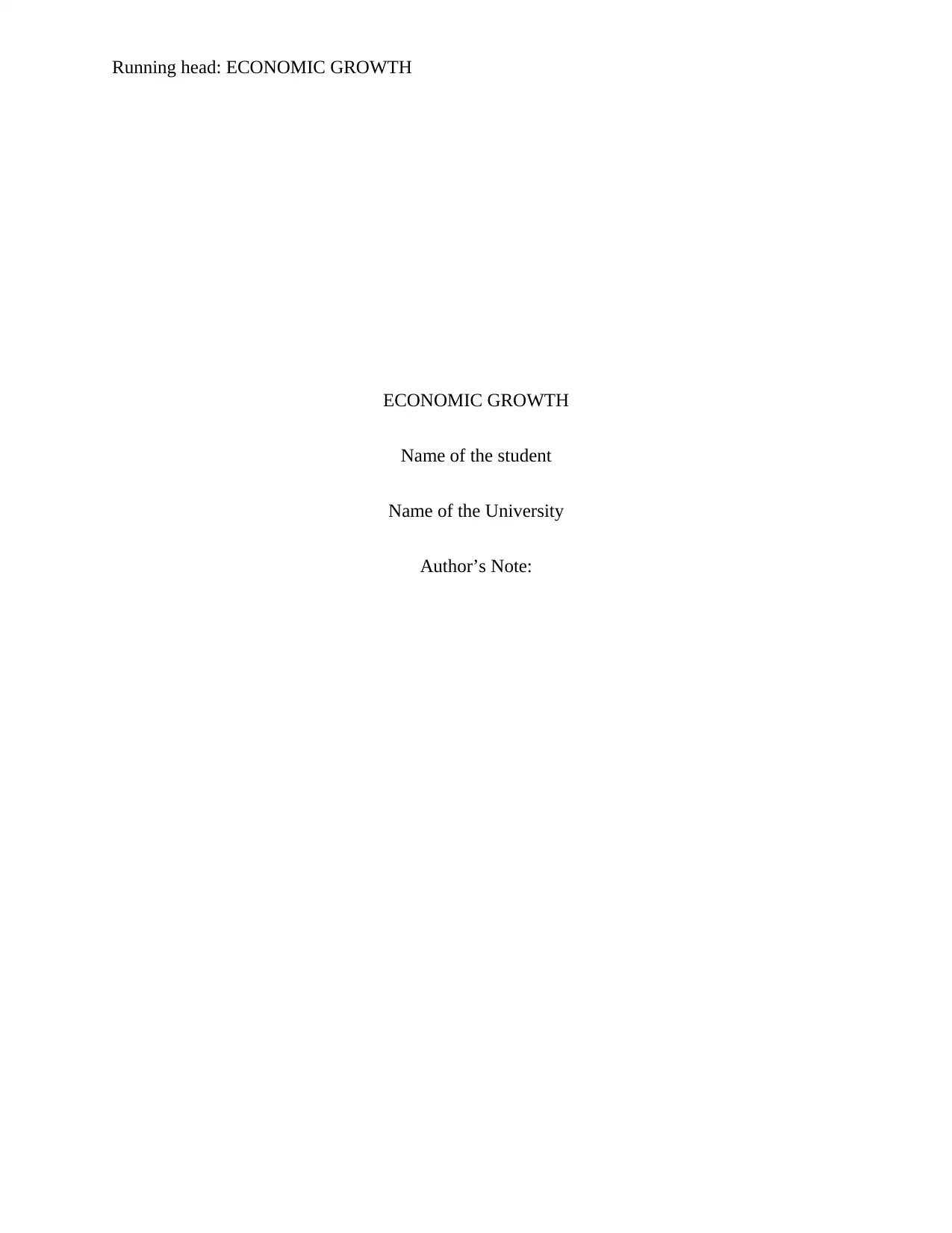
Running head: ECONOMIC GROWTH
ECONOMIC GROWTH
Name of the student
Name of the University
Author’s Note:
ECONOMIC GROWTH
Name of the student
Name of the University
Author’s Note:
Paraphrase This Document
Need a fresh take? Get an instant paraphrase of this document with our AI Paraphraser
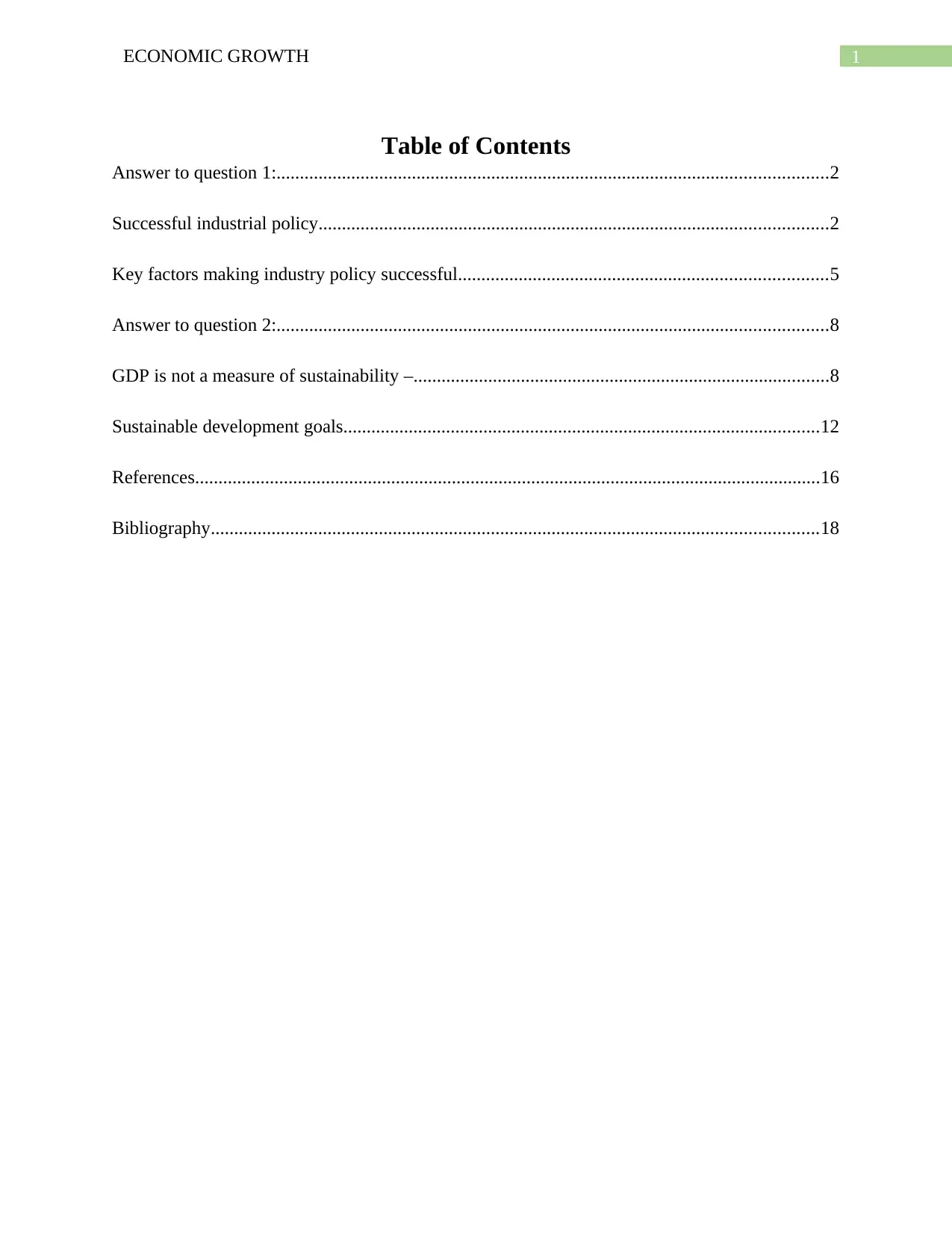
1ECONOMIC GROWTH
Table of Contents
Answer to question 1:......................................................................................................................2
Successful industrial policy.............................................................................................................2
Key factors making industry policy successful...............................................................................5
Answer to question 2:......................................................................................................................8
GDP is not a measure of sustainability –.........................................................................................8
Sustainable development goals......................................................................................................12
References......................................................................................................................................16
Bibliography..................................................................................................................................18
Table of Contents
Answer to question 1:......................................................................................................................2
Successful industrial policy.............................................................................................................2
Key factors making industry policy successful...............................................................................5
Answer to question 2:......................................................................................................................8
GDP is not a measure of sustainability –.........................................................................................8
Sustainable development goals......................................................................................................12
References......................................................................................................................................16
Bibliography..................................................................................................................................18

2ECONOMIC GROWTH
Answer to question 1:
Successful industrial policy
Industrial policy can be defined as a development in economic growth in different sectors
with the efforts made by a country. The state has to take some strategic initiatives to encourage
the development of the economy. In simple words, the state can make any decision to get better
prospects for the economic growth of a country. The Economic growth of a nation depends upon
the productivity of more goods and services with the same input. Industrial policy is design to
increase the economic development of a state that creates financial wealth for all citizens. It is a
funded program that encourages the private and public sectors to develop new technology and
build new industries. These policies might save the industries and increase the GDP of a country.
The Government carries these programs in different and many ways. Most of the time,
these policies favor the growth and development of the economic sector. But, the question arises;
do these policies work? All industrial countries need more resources to carry the function of
these industries and develop their growth in the industrial sector. Industrial policy means
different to different people, and people perceive it on their own experiences (Maloney (2018)).
Many people argue the policies of Government and raise their concerns as the owners of
industries are not favoring the ideas of state owners. The owners simply want to earn and make
money. They do not follow the instructions of policymakers who put forward a framework
according to the need of a domestic people. The firmer side of the argument might be raised that
the local industry could get their profit on low production costs. These short versions are based
on global interest.
Answer to question 1:
Successful industrial policy
Industrial policy can be defined as a development in economic growth in different sectors
with the efforts made by a country. The state has to take some strategic initiatives to encourage
the development of the economy. In simple words, the state can make any decision to get better
prospects for the economic growth of a country. The Economic growth of a nation depends upon
the productivity of more goods and services with the same input. Industrial policy is design to
increase the economic development of a state that creates financial wealth for all citizens. It is a
funded program that encourages the private and public sectors to develop new technology and
build new industries. These policies might save the industries and increase the GDP of a country.
The Government carries these programs in different and many ways. Most of the time,
these policies favor the growth and development of the economic sector. But, the question arises;
do these policies work? All industrial countries need more resources to carry the function of
these industries and develop their growth in the industrial sector. Industrial policy means
different to different people, and people perceive it on their own experiences (Maloney (2018)).
Many people argue the policies of Government and raise their concerns as the owners of
industries are not favoring the ideas of state owners. The owners simply want to earn and make
money. They do not follow the instructions of policymakers who put forward a framework
according to the need of a domestic people. The firmer side of the argument might be raised that
the local industry could get their profit on low production costs. These short versions are based
on global interest.
⊘ This is a preview!⊘
Do you want full access?
Subscribe today to unlock all pages.

Trusted by 1+ million students worldwide
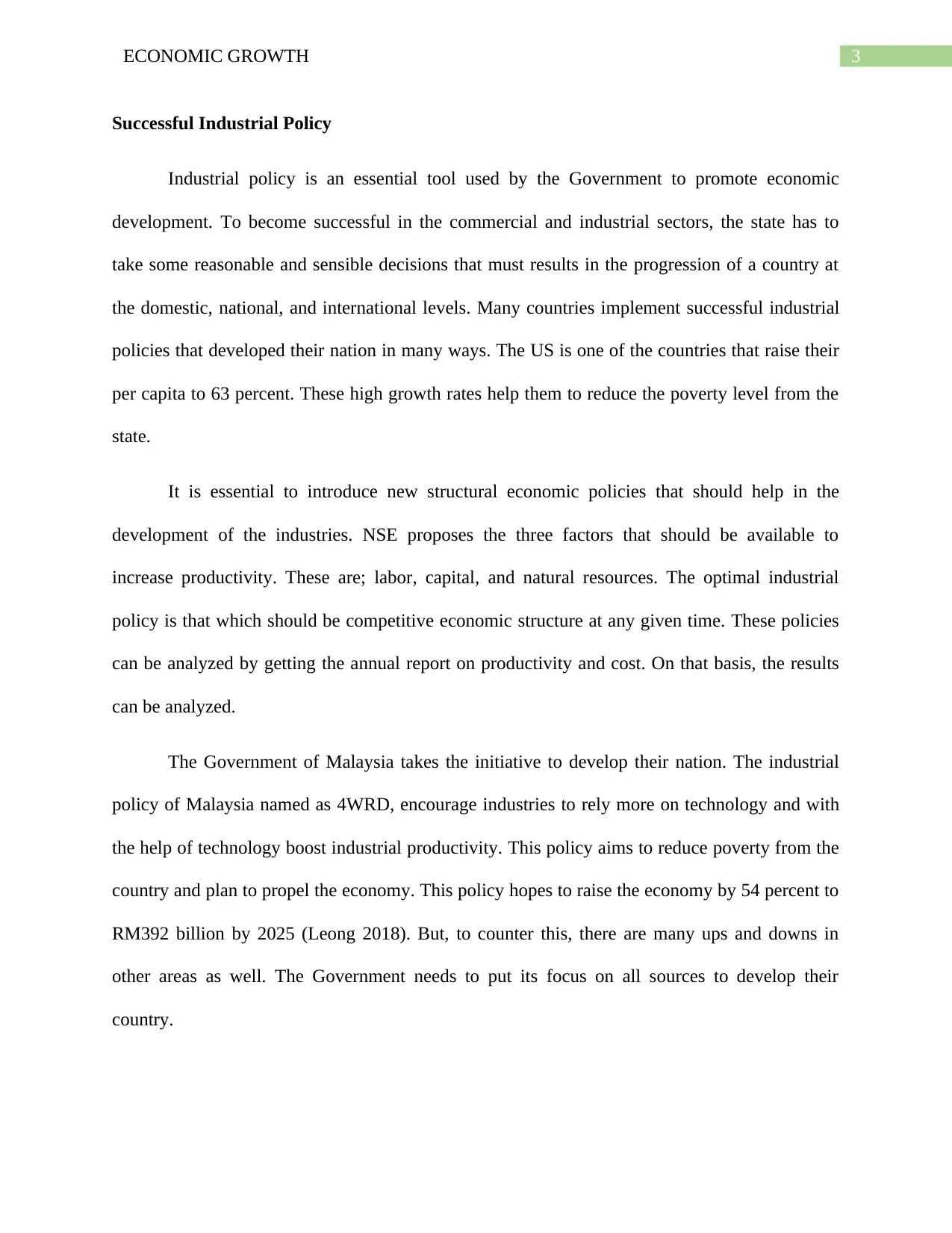
3ECONOMIC GROWTH
Successful Industrial Policy
Industrial policy is an essential tool used by the Government to promote economic
development. To become successful in the commercial and industrial sectors, the state has to
take some reasonable and sensible decisions that must results in the progression of a country at
the domestic, national, and international levels. Many countries implement successful industrial
policies that developed their nation in many ways. The US is one of the countries that raise their
per capita to 63 percent. These high growth rates help them to reduce the poverty level from the
state.
It is essential to introduce new structural economic policies that should help in the
development of the industries. NSE proposes the three factors that should be available to
increase productivity. These are; labor, capital, and natural resources. The optimal industrial
policy is that which should be competitive economic structure at any given time. These policies
can be analyzed by getting the annual report on productivity and cost. On that basis, the results
can be analyzed.
The Government of Malaysia takes the initiative to develop their nation. The industrial
policy of Malaysia named as 4WRD, encourage industries to rely more on technology and with
the help of technology boost industrial productivity. This policy aims to reduce poverty from the
country and plan to propel the economy. This policy hopes to raise the economy by 54 percent to
RM392 billion by 2025 (Leong 2018). But, to counter this, there are many ups and downs in
other areas as well. The Government needs to put its focus on all sources to develop their
country.
Successful Industrial Policy
Industrial policy is an essential tool used by the Government to promote economic
development. To become successful in the commercial and industrial sectors, the state has to
take some reasonable and sensible decisions that must results in the progression of a country at
the domestic, national, and international levels. Many countries implement successful industrial
policies that developed their nation in many ways. The US is one of the countries that raise their
per capita to 63 percent. These high growth rates help them to reduce the poverty level from the
state.
It is essential to introduce new structural economic policies that should help in the
development of the industries. NSE proposes the three factors that should be available to
increase productivity. These are; labor, capital, and natural resources. The optimal industrial
policy is that which should be competitive economic structure at any given time. These policies
can be analyzed by getting the annual report on productivity and cost. On that basis, the results
can be analyzed.
The Government of Malaysia takes the initiative to develop their nation. The industrial
policy of Malaysia named as 4WRD, encourage industries to rely more on technology and with
the help of technology boost industrial productivity. This policy aims to reduce poverty from the
country and plan to propel the economy. This policy hopes to raise the economy by 54 percent to
RM392 billion by 2025 (Leong 2018). But, to counter this, there are many ups and downs in
other areas as well. The Government needs to put its focus on all sources to develop their
country.
Paraphrase This Document
Need a fresh take? Get an instant paraphrase of this document with our AI Paraphraser
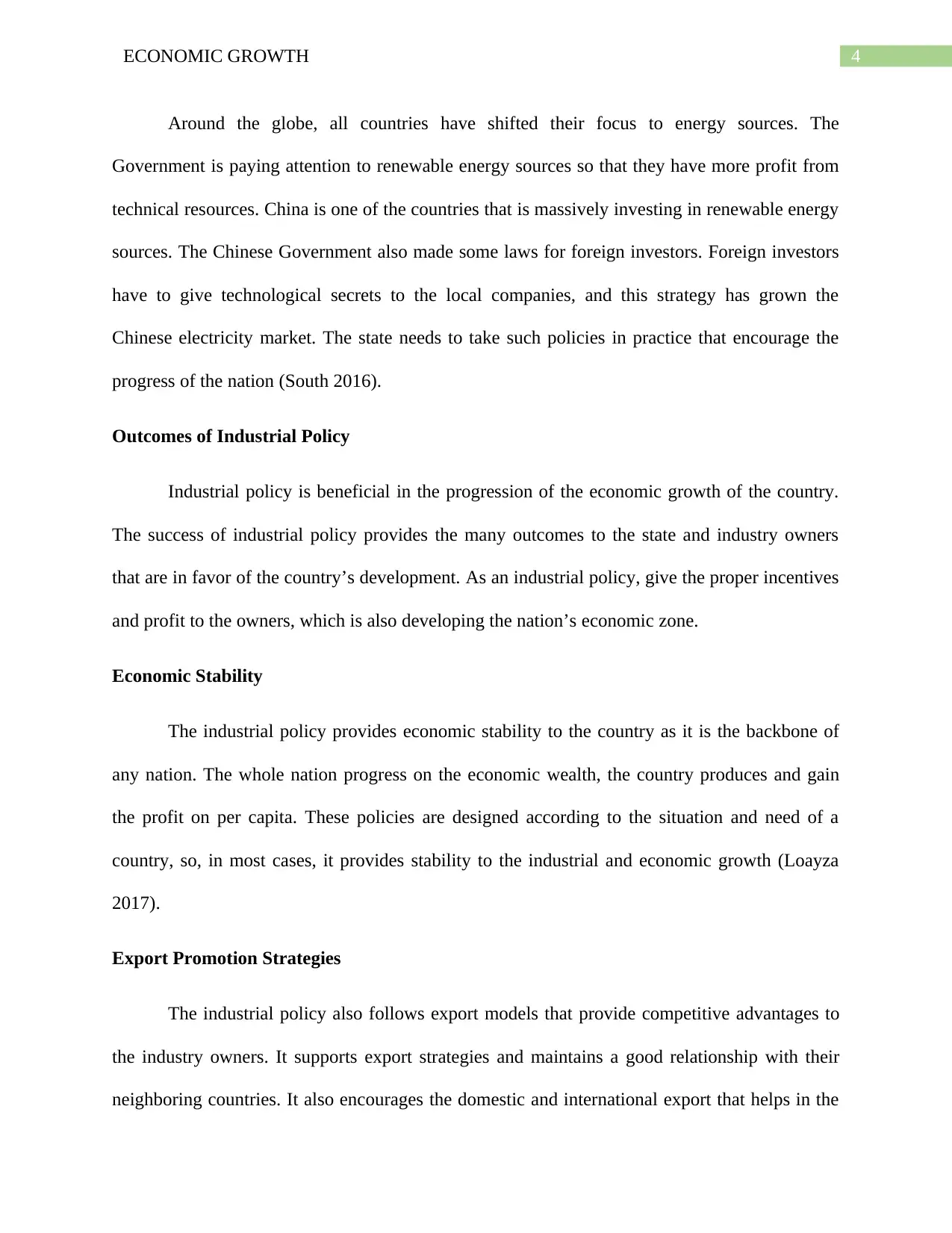
4ECONOMIC GROWTH
Around the globe, all countries have shifted their focus to energy sources. The
Government is paying attention to renewable energy sources so that they have more profit from
technical resources. China is one of the countries that is massively investing in renewable energy
sources. The Chinese Government also made some laws for foreign investors. Foreign investors
have to give technological secrets to the local companies, and this strategy has grown the
Chinese electricity market. The state needs to take such policies in practice that encourage the
progress of the nation (South 2016).
Outcomes of Industrial Policy
Industrial policy is beneficial in the progression of the economic growth of the country.
The success of industrial policy provides the many outcomes to the state and industry owners
that are in favor of the country’s development. As an industrial policy, give the proper incentives
and profit to the owners, which is also developing the nation’s economic zone.
Economic Stability
The industrial policy provides economic stability to the country as it is the backbone of
any nation. The whole nation progress on the economic wealth, the country produces and gain
the profit on per capita. These policies are designed according to the situation and need of a
country, so, in most cases, it provides stability to the industrial and economic growth (Loayza
2017).
Export Promotion Strategies
The industrial policy also follows export models that provide competitive advantages to
the industry owners. It supports export strategies and maintains a good relationship with their
neighboring countries. It also encourages the domestic and international export that helps in the
Around the globe, all countries have shifted their focus to energy sources. The
Government is paying attention to renewable energy sources so that they have more profit from
technical resources. China is one of the countries that is massively investing in renewable energy
sources. The Chinese Government also made some laws for foreign investors. Foreign investors
have to give technological secrets to the local companies, and this strategy has grown the
Chinese electricity market. The state needs to take such policies in practice that encourage the
progress of the nation (South 2016).
Outcomes of Industrial Policy
Industrial policy is beneficial in the progression of the economic growth of the country.
The success of industrial policy provides the many outcomes to the state and industry owners
that are in favor of the country’s development. As an industrial policy, give the proper incentives
and profit to the owners, which is also developing the nation’s economic zone.
Economic Stability
The industrial policy provides economic stability to the country as it is the backbone of
any nation. The whole nation progress on the economic wealth, the country produces and gain
the profit on per capita. These policies are designed according to the situation and need of a
country, so, in most cases, it provides stability to the industrial and economic growth (Loayza
2017).
Export Promotion Strategies
The industrial policy also follows export models that provide competitive advantages to
the industry owners. It supports export strategies and maintains a good relationship with their
neighboring countries. It also encourages the domestic and international export that helps in the
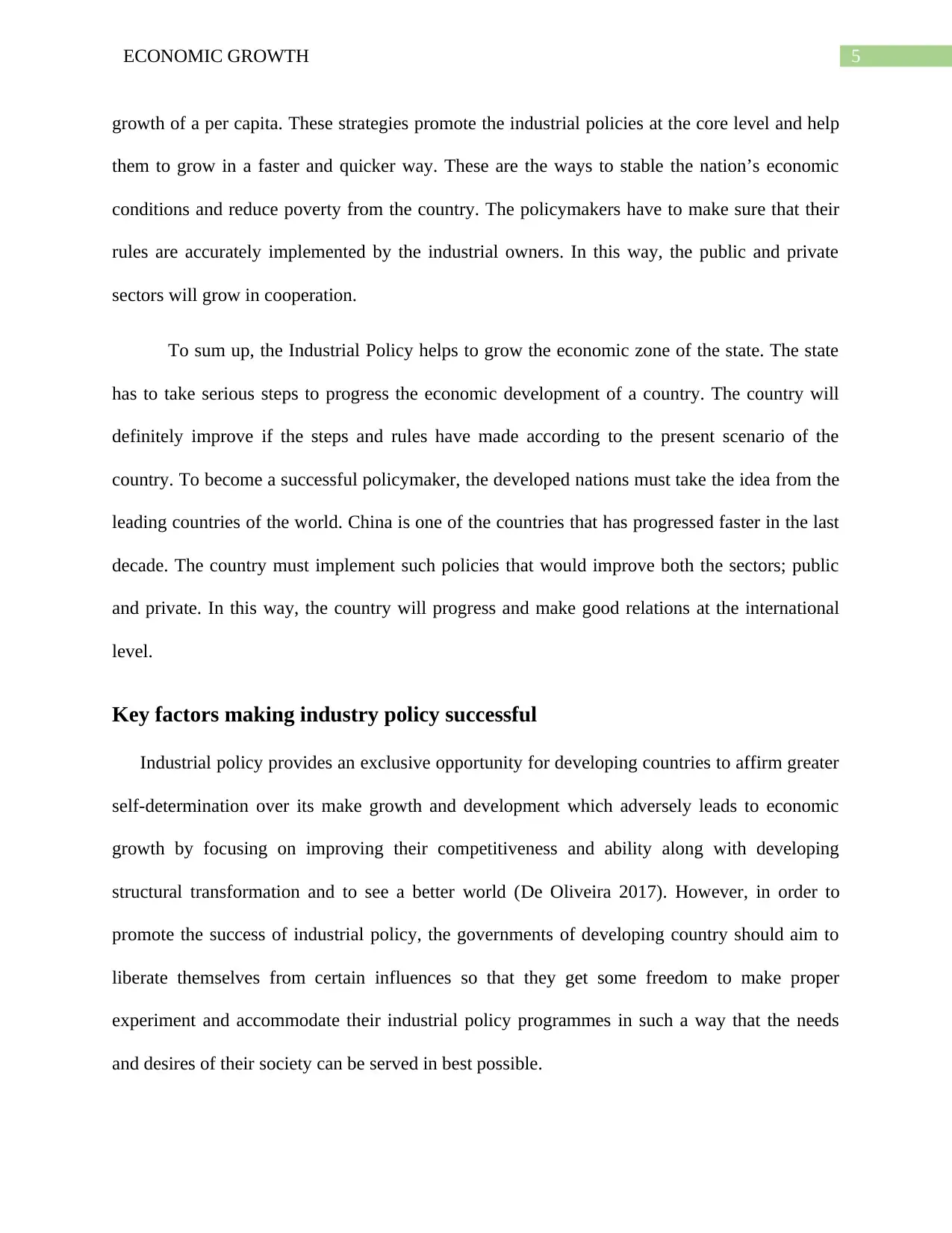
5ECONOMIC GROWTH
growth of a per capita. These strategies promote the industrial policies at the core level and help
them to grow in a faster and quicker way. These are the ways to stable the nation’s economic
conditions and reduce poverty from the country. The policymakers have to make sure that their
rules are accurately implemented by the industrial owners. In this way, the public and private
sectors will grow in cooperation.
To sum up, the Industrial Policy helps to grow the economic zone of the state. The state
has to take serious steps to progress the economic development of a country. The country will
definitely improve if the steps and rules have made according to the present scenario of the
country. To become a successful policymaker, the developed nations must take the idea from the
leading countries of the world. China is one of the countries that has progressed faster in the last
decade. The country must implement such policies that would improve both the sectors; public
and private. In this way, the country will progress and make good relations at the international
level.
Key factors making industry policy successful
Industrial policy provides an exclusive opportunity for developing countries to affirm greater
self-determination over its make growth and development which adversely leads to economic
growth by focusing on improving their competitiveness and ability along with developing
structural transformation and to see a better world (De Oliveira 2017). However, in order to
promote the success of industrial policy, the governments of developing country should aim to
liberate themselves from certain influences so that they get some freedom to make proper
experiment and accommodate their industrial policy programmes in such a way that the needs
and desires of their society can be served in best possible.
growth of a per capita. These strategies promote the industrial policies at the core level and help
them to grow in a faster and quicker way. These are the ways to stable the nation’s economic
conditions and reduce poverty from the country. The policymakers have to make sure that their
rules are accurately implemented by the industrial owners. In this way, the public and private
sectors will grow in cooperation.
To sum up, the Industrial Policy helps to grow the economic zone of the state. The state
has to take serious steps to progress the economic development of a country. The country will
definitely improve if the steps and rules have made according to the present scenario of the
country. To become a successful policymaker, the developed nations must take the idea from the
leading countries of the world. China is one of the countries that has progressed faster in the last
decade. The country must implement such policies that would improve both the sectors; public
and private. In this way, the country will progress and make good relations at the international
level.
Key factors making industry policy successful
Industrial policy provides an exclusive opportunity for developing countries to affirm greater
self-determination over its make growth and development which adversely leads to economic
growth by focusing on improving their competitiveness and ability along with developing
structural transformation and to see a better world (De Oliveira 2017). However, in order to
promote the success of industrial policy, the governments of developing country should aim to
liberate themselves from certain influences so that they get some freedom to make proper
experiment and accommodate their industrial policy programmes in such a way that the needs
and desires of their society can be served in best possible.
⊘ This is a preview!⊘
Do you want full access?
Subscribe today to unlock all pages.

Trusted by 1+ million students worldwide

6ECONOMIC GROWTH
The Fourth Industrial Revolution or it can be named as Industry 4.0 which has been an
existing term on the minds of industry players, researchers and common people. It aims to depict
future making a stand related to accelerated interruption along with growth of new technologies
focusing on changing daily lives and creating positive outcome. Industry 4.0 has been classified
as an upcoming phase of transformation in the manufacturing sector.
Malaysia’s National Policy on Industry 4.0 or Industry4WRD
Industry4WRD is mainly concerned with changing Malaysia’s manufacturing sector in a
digital way along with its respective services for embracement of Industry 4.0. There is an
anticipation by policy that Malaysia act as significant partner for manufacturing in a smart way,
along with industries having high-technology and provider of total solutions for the
manufacturing sector in the region. For Malaysian economy, manufacturing sector has been an
important growth operator making a contribution of almost 23% to the gross domestic product
(GDP) of the country in the last five years. There has been a mark of a 5.1% average growth in
the respective sectors by the government in the period of 2016 and 2020 comparing with an
average of 4.8% in next five years before 2016. The country Malaysia feels the important to
grasp Industry 4.0 as fast as they can so that there can be an increase in their productivity at
national level. In addition, there is intention of creating high skill level of employment
opportunities along with raising innovation capabilities and competitiveness. The policy
encourages industries to be more dependent on technologies and to expend their productivity with the
help of such advancement of technologies. However, as Malaysia desire to enlarge its on-going
structural reforms and become a developed nation, Industry4WRD policy serve as a vital step for
it which is appropriate, comprehensive and sustainable by 2025 or even before that.
The Fourth Industrial Revolution or it can be named as Industry 4.0 which has been an
existing term on the minds of industry players, researchers and common people. It aims to depict
future making a stand related to accelerated interruption along with growth of new technologies
focusing on changing daily lives and creating positive outcome. Industry 4.0 has been classified
as an upcoming phase of transformation in the manufacturing sector.
Malaysia’s National Policy on Industry 4.0 or Industry4WRD
Industry4WRD is mainly concerned with changing Malaysia’s manufacturing sector in a
digital way along with its respective services for embracement of Industry 4.0. There is an
anticipation by policy that Malaysia act as significant partner for manufacturing in a smart way,
along with industries having high-technology and provider of total solutions for the
manufacturing sector in the region. For Malaysian economy, manufacturing sector has been an
important growth operator making a contribution of almost 23% to the gross domestic product
(GDP) of the country in the last five years. There has been a mark of a 5.1% average growth in
the respective sectors by the government in the period of 2016 and 2020 comparing with an
average of 4.8% in next five years before 2016. The country Malaysia feels the important to
grasp Industry 4.0 as fast as they can so that there can be an increase in their productivity at
national level. In addition, there is intention of creating high skill level of employment
opportunities along with raising innovation capabilities and competitiveness. The policy
encourages industries to be more dependent on technologies and to expend their productivity with the
help of such advancement of technologies. However, as Malaysia desire to enlarge its on-going
structural reforms and become a developed nation, Industry4WRD policy serve as a vital step for
it which is appropriate, comprehensive and sustainable by 2025 or even before that.
Paraphrase This Document
Need a fresh take? Get an instant paraphrase of this document with our AI Paraphraser

7ECONOMIC GROWTH
Moreover, attention have been given to small and medium enterprises (SMEs) by
Industry4WRD. SMEs of Malaysia consist of 98.5% of companies in the manufacturing sector
along with focusing on 42% of opportunities of employment in the country. In order to embrace
Industry, SMEs would be entrusted to Industry 4.0 through five important critical enablers. Such
enablers consist the arrangement of funding and actions based on results, proper regulatory plans
and schemes, formulation of digital community reinforced by adequate infrastructure, access to
advance technologies and the uplifting skill of labor force.
It becomes important for economy of Malaysia to make growth and development which
adversely leads several industries to focus on improving their competitiveness and ability along
with developing structural transformation. The industry policy can be more successful in
developing countries like Malaysia focusing on other relative factors-
A good Economic advice- The industrial policy maker in developing Malaysia are facing
more challenges which is primary and is stated as the constant attack of economic advice
which simply imitate the failures of past development (Bahrin et al. 2016). In order to deal
with most compelling socio-economic issues which are faced by the populations, such as
poverty, high rate of unemployment, or economic volatility such developing countries would
like to make use of best economic decision.
Advancement in Technology- Progression and changes in technology has made an intense
increase in industrial productivity and where Industry 4.0 make it feasible assemble and
evaluate data all over gadgets with a focus of making the process fast, efficient and flexible
so that good quality of products can be produce at a low cost (Rasiah 2017).
Showing efficiency to do own work- There are large number of development companies and
private authorities which tends to promise that they have recognized the best practice and can
Moreover, attention have been given to small and medium enterprises (SMEs) by
Industry4WRD. SMEs of Malaysia consist of 98.5% of companies in the manufacturing sector
along with focusing on 42% of opportunities of employment in the country. In order to embrace
Industry, SMEs would be entrusted to Industry 4.0 through five important critical enablers. Such
enablers consist the arrangement of funding and actions based on results, proper regulatory plans
and schemes, formulation of digital community reinforced by adequate infrastructure, access to
advance technologies and the uplifting skill of labor force.
It becomes important for economy of Malaysia to make growth and development which
adversely leads several industries to focus on improving their competitiveness and ability along
with developing structural transformation. The industry policy can be more successful in
developing countries like Malaysia focusing on other relative factors-
A good Economic advice- The industrial policy maker in developing Malaysia are facing
more challenges which is primary and is stated as the constant attack of economic advice
which simply imitate the failures of past development (Bahrin et al. 2016). In order to deal
with most compelling socio-economic issues which are faced by the populations, such as
poverty, high rate of unemployment, or economic volatility such developing countries would
like to make use of best economic decision.
Advancement in Technology- Progression and changes in technology has made an intense
increase in industrial productivity and where Industry 4.0 make it feasible assemble and
evaluate data all over gadgets with a focus of making the process fast, efficient and flexible
so that good quality of products can be produce at a low cost (Rasiah 2017).
Showing efficiency to do own work- There are large number of development companies and
private authorities which tends to promise that they have recognized the best practice and can
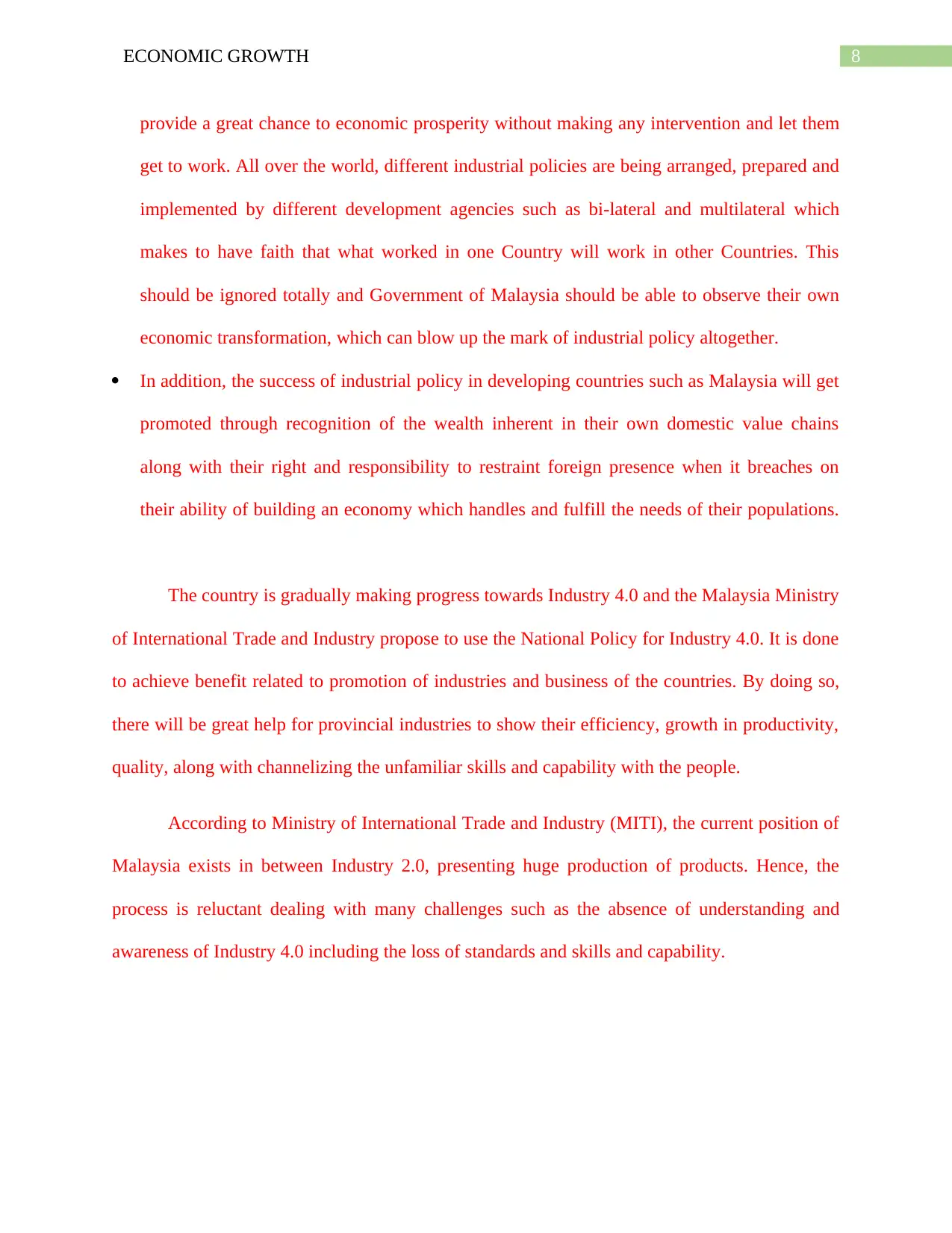
8ECONOMIC GROWTH
provide a great chance to economic prosperity without making any intervention and let them
get to work. All over the world, different industrial policies are being arranged, prepared and
implemented by different development agencies such as bi-lateral and multilateral which
makes to have faith that what worked in one Country will work in other Countries. This
should be ignored totally and Government of Malaysia should be able to observe their own
economic transformation, which can blow up the mark of industrial policy altogether.
In addition, the success of industrial policy in developing countries such as Malaysia will get
promoted through recognition of the wealth inherent in their own domestic value chains
along with their right and responsibility to restraint foreign presence when it breaches on
their ability of building an economy which handles and fulfill the needs of their populations.
The country is gradually making progress towards Industry 4.0 and the Malaysia Ministry
of International Trade and Industry propose to use the National Policy for Industry 4.0. It is done
to achieve benefit related to promotion of industries and business of the countries. By doing so,
there will be great help for provincial industries to show their efficiency, growth in productivity,
quality, along with channelizing the unfamiliar skills and capability with the people.
According to Ministry of International Trade and Industry (MITI), the current position of
Malaysia exists in between Industry 2.0, presenting huge production of products. Hence, the
process is reluctant dealing with many challenges such as the absence of understanding and
awareness of Industry 4.0 including the loss of standards and skills and capability.
provide a great chance to economic prosperity without making any intervention and let them
get to work. All over the world, different industrial policies are being arranged, prepared and
implemented by different development agencies such as bi-lateral and multilateral which
makes to have faith that what worked in one Country will work in other Countries. This
should be ignored totally and Government of Malaysia should be able to observe their own
economic transformation, which can blow up the mark of industrial policy altogether.
In addition, the success of industrial policy in developing countries such as Malaysia will get
promoted through recognition of the wealth inherent in their own domestic value chains
along with their right and responsibility to restraint foreign presence when it breaches on
their ability of building an economy which handles and fulfill the needs of their populations.
The country is gradually making progress towards Industry 4.0 and the Malaysia Ministry
of International Trade and Industry propose to use the National Policy for Industry 4.0. It is done
to achieve benefit related to promotion of industries and business of the countries. By doing so,
there will be great help for provincial industries to show their efficiency, growth in productivity,
quality, along with channelizing the unfamiliar skills and capability with the people.
According to Ministry of International Trade and Industry (MITI), the current position of
Malaysia exists in between Industry 2.0, presenting huge production of products. Hence, the
process is reluctant dealing with many challenges such as the absence of understanding and
awareness of Industry 4.0 including the loss of standards and skills and capability.
⊘ This is a preview!⊘
Do you want full access?
Subscribe today to unlock all pages.

Trusted by 1+ million students worldwide

9ECONOMIC GROWTH
Answer to question 2:
GDP is not a measure of sustainability –
This project signifies the role of depletion of natural resources and environmental
damages in the country's sustainable development. The project will explain how GDP is not a
contributor to sustainability. The point will be put forward by taking the example of Malaysia's
economy. The growth is taking place since around 1980, but this growth is "un-economic"
because human welfare per capita has not shown any improvement at all. Adjusted cost for in-
equality, the price for environmental damage, and other factors that affect welfare forms human
welfare per capita. The real economy comprises of the natural capital assets, the resources that
are not human-made, and are significantly valuable. These include climate control, pollination,
water supply, and recreation. The natural assets are the main contributor to economic growth, for
human well-being instead of all the combined GDPs. (Kurniawan and Managi 2017).
For economic growth and development worldwide, sustainability has become an essential
concept. Malaysia is a fast developing economy in continent Asia, and it has shown a
tremendous upward economic growth; though, a major question arises - is it growing in the
sustainability path? It is because of weak traditional GDP is reflecting in sustainability path, the
adjustments should be made in calculations for implementation of Green GDP, which is a
reflector of sustainability (Stjepanović, Tomić and Škare 2017). The measure will provide a
more dubious estimate to policymakers regarding the area of environmental challenges. Some
uncertainties are linked with Green GDP, like for estimating data, there are no such
comprehensive calculations, and difficulties are existing for setting natural resources value. GDP
disregards externalities, particularly environmental externalities if evaluated from sustainability
Answer to question 2:
GDP is not a measure of sustainability –
This project signifies the role of depletion of natural resources and environmental
damages in the country's sustainable development. The project will explain how GDP is not a
contributor to sustainability. The point will be put forward by taking the example of Malaysia's
economy. The growth is taking place since around 1980, but this growth is "un-economic"
because human welfare per capita has not shown any improvement at all. Adjusted cost for in-
equality, the price for environmental damage, and other factors that affect welfare forms human
welfare per capita. The real economy comprises of the natural capital assets, the resources that
are not human-made, and are significantly valuable. These include climate control, pollination,
water supply, and recreation. The natural assets are the main contributor to economic growth, for
human well-being instead of all the combined GDPs. (Kurniawan and Managi 2017).
For economic growth and development worldwide, sustainability has become an essential
concept. Malaysia is a fast developing economy in continent Asia, and it has shown a
tremendous upward economic growth; though, a major question arises - is it growing in the
sustainability path? It is because of weak traditional GDP is reflecting in sustainability path, the
adjustments should be made in calculations for implementation of Green GDP, which is a
reflector of sustainability (Stjepanović, Tomić and Škare 2017). The measure will provide a
more dubious estimate to policymakers regarding the area of environmental challenges. Some
uncertainties are linked with Green GDP, like for estimating data, there are no such
comprehensive calculations, and difficulties are existing for setting natural resources value. GDP
disregards externalities, particularly environmental externalities if evaluated from sustainability
Paraphrase This Document
Need a fresh take? Get an instant paraphrase of this document with our AI Paraphraser
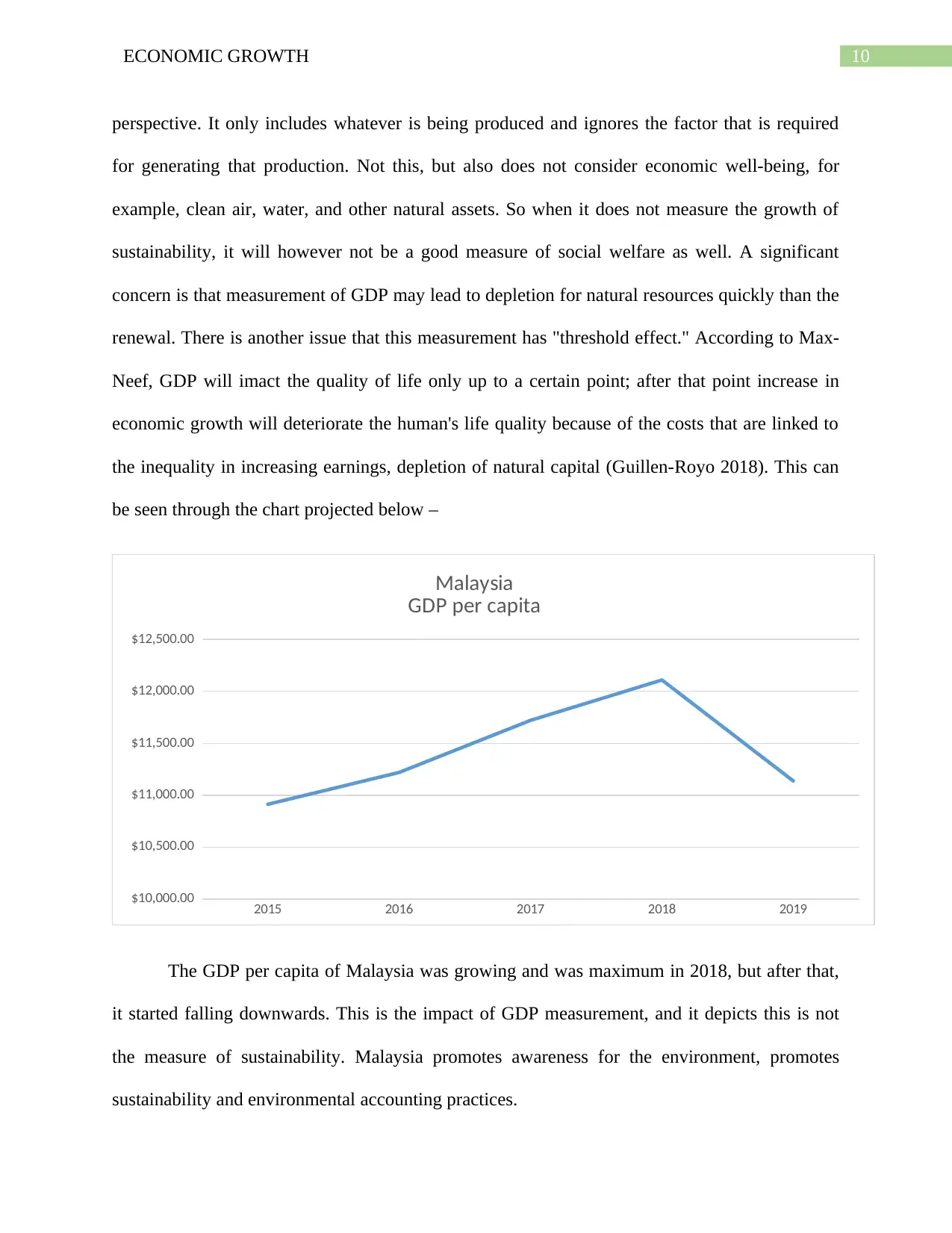
10ECONOMIC GROWTH
perspective. It only includes whatever is being produced and ignores the factor that is required
for generating that production. Not this, but also does not consider economic well-being, for
example, clean air, water, and other natural assets. So when it does not measure the growth of
sustainability, it will however not be a good measure of social welfare as well. A significant
concern is that measurement of GDP may lead to depletion for natural resources quickly than the
renewal. There is another issue that this measurement has "threshold effect." According to Max-
Neef, GDP will imact the quality of life only up to a certain point; after that point increase in
economic growth will deteriorate the human's life quality because of the costs that are linked to
the inequality in increasing earnings, depletion of natural capital (Guillen-Royo 2018). This can
be seen through the chart projected below –
2015 2016 2017 2018 2019
$10,000.00
$10,500.00
$11,000.00
$11,500.00
$12,000.00
$12,500.00
Malaysia
GDP per capita
The GDP per capita of Malaysia was growing and was maximum in 2018, but after that,
it started falling downwards. This is the impact of GDP measurement, and it depicts this is not
the measure of sustainability. Malaysia promotes awareness for the environment, promotes
sustainability and environmental accounting practices.
perspective. It only includes whatever is being produced and ignores the factor that is required
for generating that production. Not this, but also does not consider economic well-being, for
example, clean air, water, and other natural assets. So when it does not measure the growth of
sustainability, it will however not be a good measure of social welfare as well. A significant
concern is that measurement of GDP may lead to depletion for natural resources quickly than the
renewal. There is another issue that this measurement has "threshold effect." According to Max-
Neef, GDP will imact the quality of life only up to a certain point; after that point increase in
economic growth will deteriorate the human's life quality because of the costs that are linked to
the inequality in increasing earnings, depletion of natural capital (Guillen-Royo 2018). This can
be seen through the chart projected below –
2015 2016 2017 2018 2019
$10,000.00
$10,500.00
$11,000.00
$11,500.00
$12,000.00
$12,500.00
Malaysia
GDP per capita
The GDP per capita of Malaysia was growing and was maximum in 2018, but after that,
it started falling downwards. This is the impact of GDP measurement, and it depicts this is not
the measure of sustainability. Malaysia promotes awareness for the environment, promotes
sustainability and environmental accounting practices.
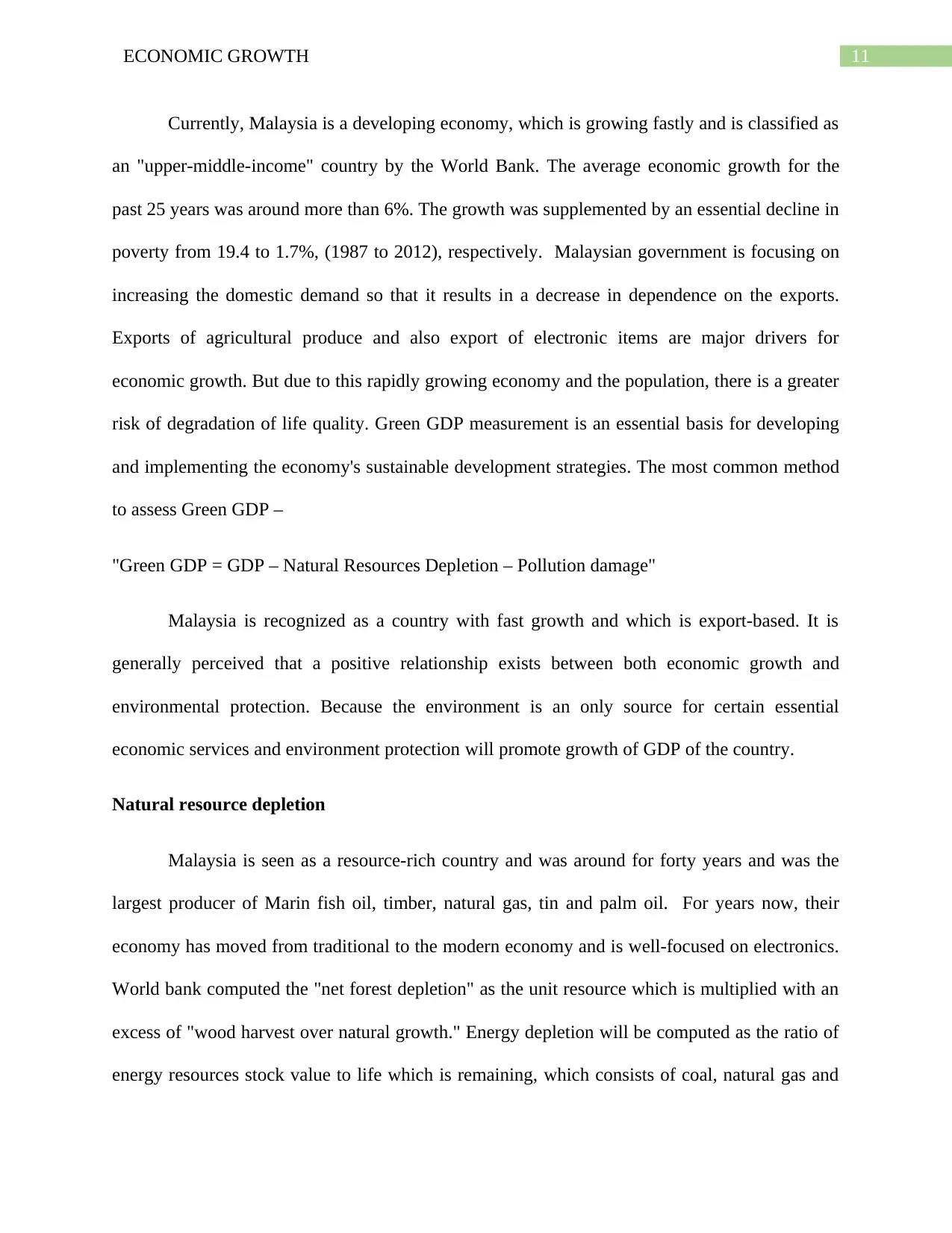
11ECONOMIC GROWTH
Currently, Malaysia is a developing economy, which is growing fastly and is classified as
an "upper-middle-income" country by the World Bank. The average economic growth for the
past 25 years was around more than 6%. The growth was supplemented by an essential decline in
poverty from 19.4 to 1.7%, (1987 to 2012), respectively. Malaysian government is focusing on
increasing the domestic demand so that it results in a decrease in dependence on the exports.
Exports of agricultural produce and also export of electronic items are major drivers for
economic growth. But due to this rapidly growing economy and the population, there is a greater
risk of degradation of life quality. Green GDP measurement is an essential basis for developing
and implementing the economy's sustainable development strategies. The most common method
to assess Green GDP –
"Green GDP = GDP – Natural Resources Depletion – Pollution damage"
Malaysia is recognized as a country with fast growth and which is export-based. It is
generally perceived that a positive relationship exists between both economic growth and
environmental protection. Because the environment is an only source for certain essential
economic services and environment protection will promote growth of GDP of the country.
Natural resource depletion
Malaysia is seen as a resource-rich country and was around for forty years and was the
largest producer of Marin fish oil, timber, natural gas, tin and palm oil. For years now, their
economy has moved from traditional to the modern economy and is well-focused on electronics.
World bank computed the "net forest depletion" as the unit resource which is multiplied with an
excess of "wood harvest over natural growth." Energy depletion will be computed as the ratio of
energy resources stock value to life which is remaining, which consists of coal, natural gas and
Currently, Malaysia is a developing economy, which is growing fastly and is classified as
an "upper-middle-income" country by the World Bank. The average economic growth for the
past 25 years was around more than 6%. The growth was supplemented by an essential decline in
poverty from 19.4 to 1.7%, (1987 to 2012), respectively. Malaysian government is focusing on
increasing the domestic demand so that it results in a decrease in dependence on the exports.
Exports of agricultural produce and also export of electronic items are major drivers for
economic growth. But due to this rapidly growing economy and the population, there is a greater
risk of degradation of life quality. Green GDP measurement is an essential basis for developing
and implementing the economy's sustainable development strategies. The most common method
to assess Green GDP –
"Green GDP = GDP – Natural Resources Depletion – Pollution damage"
Malaysia is recognized as a country with fast growth and which is export-based. It is
generally perceived that a positive relationship exists between both economic growth and
environmental protection. Because the environment is an only source for certain essential
economic services and environment protection will promote growth of GDP of the country.
Natural resource depletion
Malaysia is seen as a resource-rich country and was around for forty years and was the
largest producer of Marin fish oil, timber, natural gas, tin and palm oil. For years now, their
economy has moved from traditional to the modern economy and is well-focused on electronics.
World bank computed the "net forest depletion" as the unit resource which is multiplied with an
excess of "wood harvest over natural growth." Energy depletion will be computed as the ratio of
energy resources stock value to life which is remaining, which consists of coal, natural gas and
⊘ This is a preview!⊘
Do you want full access?
Subscribe today to unlock all pages.

Trusted by 1+ million students worldwide
1 out of 20
Related Documents
Your All-in-One AI-Powered Toolkit for Academic Success.
+13062052269
info@desklib.com
Available 24*7 on WhatsApp / Email
![[object Object]](/_next/static/media/star-bottom.7253800d.svg)
Unlock your academic potential
Copyright © 2020–2025 A2Z Services. All Rights Reserved. Developed and managed by ZUCOL.




